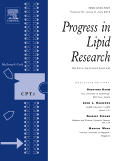
PROGRESS IN LIPID RESEARCH
Scope & Guideline
Elevating Lipid Research to New Heights
Introduction
Aims and Scopes
- Lipid Metabolism and Health Implications:
Research exploring how different types of lipids, such as omega-3 fatty acids and sphingolipids, impact human health, particularly in relation to cardiovascular, neurological, and metabolic diseases. - Structural and Functional Lipid Biology:
Studies detailing the molecular structure and functional roles of lipids in cellular processes, including lipid signaling, membrane dynamics, and interactions with proteins. - Lipidomics and Analytical Techniques:
Development and application of advanced lipidomic and analytical methodologies to profile lipid species in biological samples, contributing to a deeper understanding of lipid functions and interactions. - Lipid Roles in Disease Mechanisms:
Investigations into how alterations in lipid metabolism contribute to disease pathogenesis, including cancer, neurodegenerative disorders, and metabolic syndromes. - Plant and Microbial Lipid Research:
Research focusing on lipids in plants and microorganisms, including biosynthesis pathways, ecological significance, and potential applications in biotechnology and health.
Trending and Emerging
- Lipid Signaling and Disease:
There is an increasing focus on how lipid signaling pathways influence various diseases, including cancer and neurodegenerative disorders, highlighting the therapeutic potential of targeting lipid metabolism. - Microbiome and Lipid Interactions:
Emerging research examines the relationship between the gut microbiome and lipid metabolism, exploring how dietary lipids affect microbiota composition and function, and vice versa. - Innovative Therapeutic Uses of Lipids:
A trend towards investigating novel lipid-based therapies, including the use of lipid nanocarriers for drug delivery and the therapeutic potential of lipid mediators in various health conditions. - Environmental Impact on Lipid Availability:
Research addressing how climate change and environmental factors influence the availability and metabolism of essential lipids, particularly omega-3 fatty acids, is gaining traction. - Interdisciplinary Approaches to Lipid Research:
A notable trend in the integration of lipid research with other scientific disciplines, such as genomics, proteomics, and bioinformatics, to provide a more comprehensive understanding of lipid functions.
Declining or Waning
- Traditional Dietary Lipid Studies:
Research that primarily focused on the nutritional aspects of dietary lipids, such as simple comparisons of fat types, has seen a decline as more complex interactions and mechanisms are being explored. - Basic Lipid Chemistry without Biological Context:
Papers that focus solely on lipid chemistry without linking to biological implications or health effects are becoming less common, as the field shifts towards applied and integrative studies. - Historical Perspectives on Lipid Research:
Review articles providing historical context or retrospective analyses of lipid research trends are less prevalent, reflecting a move towards forward-looking research and innovative methodologies.
Similar Journals

PPAR Research
Championing Open Access in PPAR ResearchPPAR Research, an esteemed journal published by HINDAWI LTD, specializes in the rapidly evolving fields of drug discovery and pharmacology, contributing significantly to the body of research surrounding peroxisome proliferator-activated receptors (PPARs) and their roles in various biochemical processes. With an open access policy implemented since 2006, the journal ensures that its high-quality content is readily available, promoting widespread dissemination of knowledge. Currently ranked in the Q2 category for both Drug Discovery and Medical Pharmacology, it boasts a respectable position within the scientific community, evidenced by its Scopus rankings. PPAR Research serves as an essential resource for researchers, professionals, and students looking to advance their understanding of PPAR biology and its implications in therapeutic development. The journal's commitment to excellence and accessibility makes it a key player in supporting innovative research and critical discussions in the life sciences.

Journal of Clinical Lipidology
Innovating lipid management for better patient outcomes.Journal of Clinical Lipidology, published by Elsevier Science Inc, is a leading platform dedicated to advancing the understanding of lipidology and its impact on cardiovascular health. With an ISSN of 1933-2874 and E-ISSN 1876-4789, this esteemed journal boasts a remarkable Q1 ranking in key medical categories, including Cardiology and Cardiovascular Medicine, Internal Medicine, and Nutrition and Dietetics, solidifying its position as a vital resource for the latest research and clinical practices. This journal not only serves as a repository for groundbreaking studies but also provides insights into complex interactions between lipid metabolism and chronic diseases, including diabetes and obesity. Researchers, practitioners, and students will find a wealth of carefully vetted articles that drive innovation and improve patient outcomes in lipid management. Although it does not currently offer open access, the Journal of Clinical Lipidology ensures high visibility through rigorous peer review and a commitment to quality, making it an essential read for anyone invested in the future of lipidology.

AMERICAN JOURNAL OF PHYSIOLOGY-ENDOCRINOLOGY AND METABOLISM
Pioneering discoveries in physiology for a healthier tomorrow.American Journal of Physiology-Endocrinology and Metabolism, published by the American Physiological Society, stands as a leading platform for disseminating high-quality research in the fields of endocrinology, diabetes, and metabolism, as well as general physiology. With an impressive impact factor placing it within the Q1 category across multiple relevant disciplines (Endocrinology, Diabetes and Metabolism; Physiology; and Medical Physiology), this journal reflects its authoritative position in the scientific community. Spanning from 1980 to 2024, the journal consistently publishes groundbreaking studies and significant findings that advance our understanding of hormonal regulation and metabolic processes. Although it does not currently offer open access, it provides valuable resources for researchers, professionals, and students alike, eager to stay at the forefront of advancements in physiological sciences. Addressed in Rockville, Maryland, its commitment to excellence and rigorous peer review ensures that every article contributes essential insights to the field.

BIOCHIMIE
Transforming Biochemical Knowledge into Medical BreakthroughsWelcome to BIOCHIMIE, a prestigious journal dedicated to advancing the field of biochemistry and related areas of medicine. Published by Elsevier France - Editions Scientifiques Medicales Elsevier, this journal has been a cornerstone of scientific communication since its inception in 1971 and will continue to contribute essential research until 2024. With an impressive impact factor and categorized in Q2 for Biochemistry and Q1 for Miscellaneous Medicine, BIOCHIMIE ranks among the top quartiles in its fields, underscoring its significance and influence in the scientific community. Targeting a wide audience of researchers, professionals, and students, the journal publishes high-quality articles that explore innovative research and developments in biochemistry, genetics, and molecular biology, reflected in its Scopus ranking of 136 out of 438 in the biochemistry category. Despite its traditional publication format, the journal remains committed to promoting impactful research that drives the future of biochemistry and molecular medicine, ensuring that readers have access to critical insights that foster advancements in health and science.

PHYCOLOGICAL RESEARCH
Illuminating the ecological significance of aquatic plants.PHYCOLOGICAL RESEARCH is a leading journal in the field of aquatic and plant sciences, published by Wiley, recognized for its commitment to advancing knowledge in the study of algae and their ecological significance. With a diverse scope encompassing ecological interactions, evolutionary behaviors, and physiological processes, PHYCOLOGICAL RESEARCH aims to provide a platform for researchers to disseminate innovative findings and insights pertinent to both agricultural and biological sciences. The journal's impressive rankings—placing it in the 74th percentile within Agricultural and Biological Sciences (miscellaneous) and holding a Q2 category in key fields—underscore its impact and importance in academia. Despite not being open access, the journal ensures broad distribution and visibility through its dedicated readership. Since its inception in 1995, PHYCOLOGICAL RESEARCH has continuously evolved, shaping and influencing the direction of research in phycology and related disciplines, making it an essential resource for students, professionals, and researchers alike.

CURRENT OPINION IN LIPIDOLOGY
Navigating the complexities of lipids and their impact on health.Current Opinion in Lipidology is a premier journal published by Lippincott Williams & Wilkins, offering critical insights into the ever-evolving landscape of lipid research. With an impressive convergence spanning from 1990 to 2024, this journal serves as an essential platform for researchers, clinicians, and professionals dedicated to the study of lipids in relation to cardiovascular health, endocrinology, and metabolism. The journal currently holds a distinguished Q1 ranking in Cardiology and Cardiovascular Medicine, Endocrinology, Diabetes and Metabolism, and Nutrition and Dietetics, showcasing its significant impact in these fields. Additionally, it ranks in the Q2 quartile for Cell Biology and Molecular Biology, underlining its comprehensive approach to lipidology. Though not open access, the content is rich with cutting-edge reviews, clinical studies, and expert opinions that aim to advance knowledge and practice in lipid metabolism, making it a valuable resource for anyone seeking to stay abreast of the latest developments in lipid research.

Nature Metabolism
Transforming metabolic research into impactful discoveries.Nature Metabolism, published by NATURE PORTFOLIO, is a leading journal dedicated to advancing the field of metabolic research and its implications across various biological systems. Since its inception in 2019, this esteemed journal has rapidly established itself as a vital resource for researchers, professionals, and students alike, reflecting its prominence through a prestigious Q1 ranking in several key categories including Cell Biology, Endocrinology, Diabetes and Metabolism, Internal Medicine, and Physiology. With an impressive Scopus ranking, underscoring its impact in Medicine and Biochemistry disciplines, Nature Metabolism offers an exceptional platform for disseminating high-quality research that explores the intricate mechanisms of metabolism and its association with health and disease. Although currently not open access, it continues to gain visibility and appreciation within the scientific community, ensuring that groundbreaking findings reach interested audiences globally from its hub in Berlin, Germany. Whether you are an experienced researcher or an aspiring student, Nature Metabolism serves as an invaluable asset in navigating the complexities of metabolic science.

BIOLOGICHESKIE MEMBRANY
Exploring the Frontiers of Cell and Molecular BiologyBIOLOGICHESKIE MEMBRANY is a critical journal in the field of Cell Biology and Molecular Biology, published by MEZHDUNARODNAYA KNIGA in the Russian Federation. With an ISSN of 0233-4755, this journal has been serving the academic community since 1996 and continues to publish cutting-edge research that advances our understanding of biological membranes and their functions. Despite being classified in Q4 quartiles for both Cell and Molecular Biology in the 2023 category rankings, the journal presents a unique platform for emerging research within these pivotal areas. Researchers, professionals, and students alike will find valuable insights in its pages as it seeks to foster a collaborative environment that encourages knowledge sharing. Although currently not available as an open-access journal, it remains an essential resource for those looking to deepen their knowledge and contribute to ongoing discussions in the biological sciences. The journal’s commitment to publishing quality research is underscored by its continuous coverage until 2024, making it a sustained reference in the field.

JOURNAL OF BIOENERGETICS AND BIOMEMBRANES
Exploring the Dynamics of Life at the Cellular LevelJOURNAL OF BIOENERGETICS AND BIOMEMBRANES, published by SPRINGER/PLENUM PUBLISHERS, is a leading journal dedicated to the study of bioenergetics and biomembranes, covering essential topics such as cellular energy transformation and membrane dynamics. Since its inception in 1976, the journal has developed a robust reputation within the scientific community, currently holding a Q3 ranking in Cell Biology and a Q2 ranking in Physiology for 2023. Boasting a prestigious Scopus Rank in both Biochemistry and Physiology, it serves as a crucial platform for disseminating pioneering research findings. With its commitment to quality and innovation, the journal plays a significant role in advancing our understanding of the fundamental processes that underlie life at the cellular level. Although it does not offer open access options, the journal remains accessible through universities and research institutions, ensuring that vital research is widely shared among scholars, professionals, and students alike. The JOURNAL OF BIOENERGETICS AND BIOMEMBRANES is essential for anyone seeking to contribute to or stay informed about developments in this dynamic field.

ANNALS OF NUTRITION AND METABOLISM
Connecting Research and Practice in NutritionANNALS OF NUTRITION AND METABOLISM is a prestigious academic journal dedicated to advancing the fields of nutrition and metabolism, published by KARGER, a renowned publisher known for its commitment to high-quality research dissemination. Founded in 1959, this journal has established itself as a crucial resource for researchers and practitioners alike, spanning an extensive range of topics that highlight the interplay between diet, health, and disease. Currently seated in Q2 categorically both in Medicine (Miscellaneous) and Nutrition and Dietetics, the journal ranks impressively within the Scopus metrics, showcasing its relevance and impact—positioned at the 80th percentile in Medicine and the 71st percentile in Nutrition. Though not open access, the journal ensures broad accessibility through various academic databases. By focusing on innovative research findings and clinical insights, the ANNALS OF NUTRITION AND METABOLISM aims to foster a deeper understanding of nutritional science, making it an indispensable platform for academics, healthcare professionals, and students alike to enhance their knowledge and contribute to ongoing discussions in this vital field.